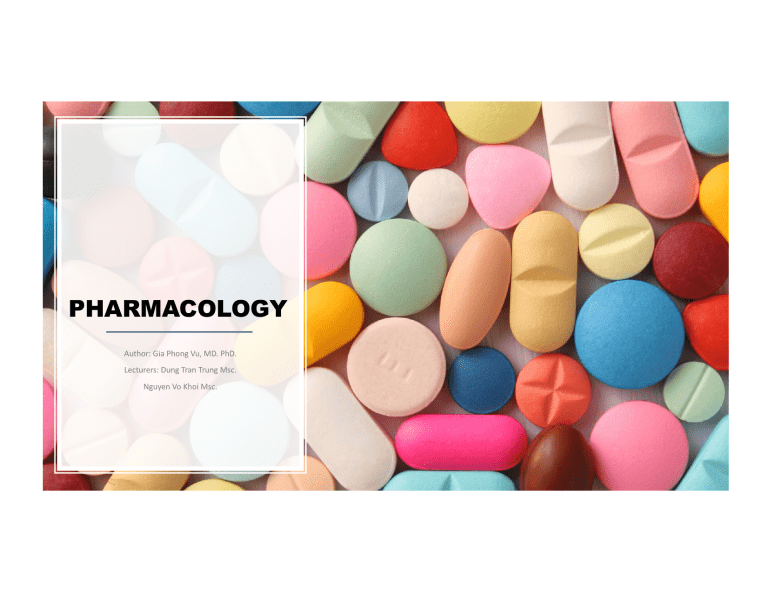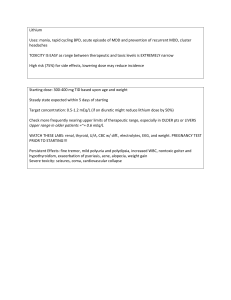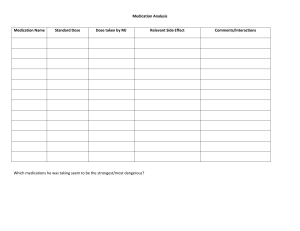
PHARMACOLOGY Author: Gia Phong Vu, MD. PhD. Lecturers: Dung Tran Trung Msc. Nguyen Vo Khoi Msc. Learning Outcomes: 1 List and define the major areas of pharmacology. 2 3 4 Describe what a drug is and explain the differences between therapeutic effect, side effect, and toxic effect. Understand the terms site of action and mechanism of action, and how agonist and antagonist drugs interact at drug receptor sites. Characterize the relationship between drug dosage and drug response, and the relationship between drug response time Learning Outcomes cont. 5 1 62 73 48 Explain the nomenclature used to name and classify drug Understand the term associate with drug safety Explain the nomenclature used to name and classify drug Recall the main drug references and the information they provide. Drug Sources Early days: v Plants • Morphine and Codein from poppy plant (Papver somniferum) • Digitalis from Foxglove • Antimalaria quinine (cinchona tree) • Paclitaxel, anticancer from yew tree) v Animals • Insulin from pigs (in the early date) • Growth hormone v Micro-organism • Early antibiotics from fungi such as Penicillium v Minerals Drug Sources Modern day: vChemical Synthetic and Semi-synthetic vProducts of modern medicine: o Molecular Biology o Gene therapy o New types of drugs such as monoclonal antibodies Major Areas of Pharmacology Area Description Pharmacodynamics Study of the action of drugs on living tissue Pharmacokinetics Study of the processes of drug absorption, distribution, metabolism, and excretion Pharmacotherapeutics Study of the use of drugs in treating disease Posology Study of the amount of drug that is required to produce therapeutic effects Toxicology Study of the harmful effects of drugs on living tissues Terminology Related to Drug Effects Major Areas of Pharmacology: • Pure drug: a chemical compound with a specific chemical structure. o Chemical properties o Biological properties • Therapeutic effect: o The intended effect of the drug • Drug indication: o Therapeutics use(s) of the drug – indications for use • Contra-indication: situation or circumstances when the drug SHOULD NOT be used. Terminology Related to Drug Effects cont. Side Effects: Adverse Effects: • Minor nuisance or annoyance caused by the drug • Cost vs. benefit • Harmful effects • Prolonged treatment may effects the function of vital organ such as liver or kidney Toxic Effects (Toxicity) • Drug poisoining, the consequences of which can be harmful and may be life-threatening • The drug must be stopped, antidotes and supportive treatment should be given next. Basic Concepts in Pharmacology • Site of Action: o Location within the body where the drug exerts its therapeutics effects • Mechanism of action: o Explain how a drug produces its effects • Receptor site: o Chemical structure located on the cell membrane or within the cell where drug(s) attached. • Agonists: o Drug that binds to a specific receptors and produce a drug action Basic Concepts in Pharmacology • Antagonists: o Drugs that binds to specific receptors and block agonist drug action or cellular function o Also known as blocking drugs– prevent body substances to bind § Example: Naloxone – morphine antagonize – treat morphine overdose o Competitive antagonism – agonist and antagonist compete administered together and compete for the same receptor site. Dose-Response Curve • A dose is the exact amount of a drug that is administered to produce a specific effect, a response. • • Drug response is proportional to the dose Maximal response (100% magnitude)increase in dose do not yield any greater effect – Ceiling effect. • Potency is a measure of the strength, or concentration, of a drug required to produce a specific effect. • The dose that will produce an effect that is half of the maximal response is referred to as the effective dose 50, or ED50 Time-Plasma Drug Concentration Curve • Duration of action is the length of time that a drug continues to produce its effect. • The time from drug administration to the first observable effect is known as the onset of action. • When the plasma drug concentration falls below the therapeutic range, there is termination of drug action. DRUG SAFETY • 2 major requirements for drugs to before it can be approved for used in humans: 1) Efficacy 2) Safety DRUG SAFETY (cont.) • LD50 – lethal dose 50 – the dose that kill 50% of the animals tested • Therapeutic Index (TI) is the ratio of LD50 to the ED50 of a drug • TI = LD50/ED50 Adverse Drug Effects (A.D.E.) • Adverse effects are dose dependent • Few adverse effects are not dose dependent such as idiosyncrasy and drug allergy – determined by individual variation Frequently affected tissues • Oral drugs often cause nausea, vomiting, diarrhea because of GI irritation. • Liver, kidneys, brain, vascular system are organs exposed to highest concentration of drugs • Birth defect drugs known as teratogens • Tumor promoting drugs known as carcinogens A.D.E. Cont. • Drug allergy occurs when an individual becomes sensitized to a particular drug • an individual may develop antibodies into a particular drug • Antigens and antibodies reactions involving drugs usually cause the release of histamine and order inflammatory mediators from cells known as mass cells. • Symptom involve, including crashes, hives, itching, nasal secretions, hypotension, bronchoconstriction. • The term anaphylaxis is used to describe serious allergic reactions. 1.6. Drug Nomenclature • Long chemical name à shorter nonpropietary (non trademark) name which is commonly a contraction of the chemical name commonly referred as generic name • Propietary name also known as trade name or brand name. 1.6. Drug Nomenclature Prescription drugs require a written or phone order (the prescription), which can only be issued by or under the direction of a licensed physician, dentist, or veterinarian. • Nonprescription drugs, usually referred to as “over-the-counter” (OTC) drugs (such as aspirin, antacids, cold remedies), can be purchased anywhere and do not require the services of a physician or pharmacist. • Lesson Review 1. The study of drug absorption, distribution, metabolism, and excretion is known as (LO 1.1) A. pharmacotherapeutics B. pharmacodynamics C. pharmacokinetics D. pharmacy E. posology 2. The medical situation when a particular drug should not be administered is referred to as (LO 1.2) A. side effect B. adverse effect C. drug allergy D. contraindication E. antagonism Lesson Review 3. An unusual or unexpected drug reaction by an individual is known as (LO 1.5) A. toxic effect B. antagonism C. idiosyncrasy D. side effect E. drug allergy 4. The proprietary drug name supplied by a pharmaceutical company is also referred to as the (LO 1.6) A. generic name B. over-the-counter name C. trade name D. chemical name E. none of these 5. The time from drug administration to the first observable drug effect is known as the (LO 1.4) A. duration of action B. onset of action C. ceiling effect D. maximal response E. ceiling effect Lesson Review 6. A drug that has the potential for abuse and is regulated by the Drug Enforcement Agency is classified as a A. poison B. OTC drug C. prescription drug D. controlled substance E. nonproprietary drug 7. Select the term that relates to the amount of drug administered to produce a therapeutic effect. ( A. posology B. toxicology C. pharmacodynamics D. pharmacotherapeutics E. pharmacy Lesson Review 8. A medication that does not require a physician’s service to obtain is referred to as (LO 1.6) A. trade B. nonproprietary C. nonprescription D. brand E. generic 9. Which of the following could be categorized as an adverse reaction? (LO 1.5) A. idiosyncrasy B. drug allergy C. teratogenicity D. carcinogenicity E. all of these 10. The time a drug continues to produce its effect is its (LO 1.4) A. ED50 B. maximal response C. ceiling effect D. onset of action E. duration of action






